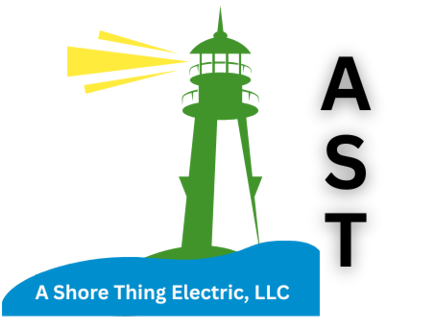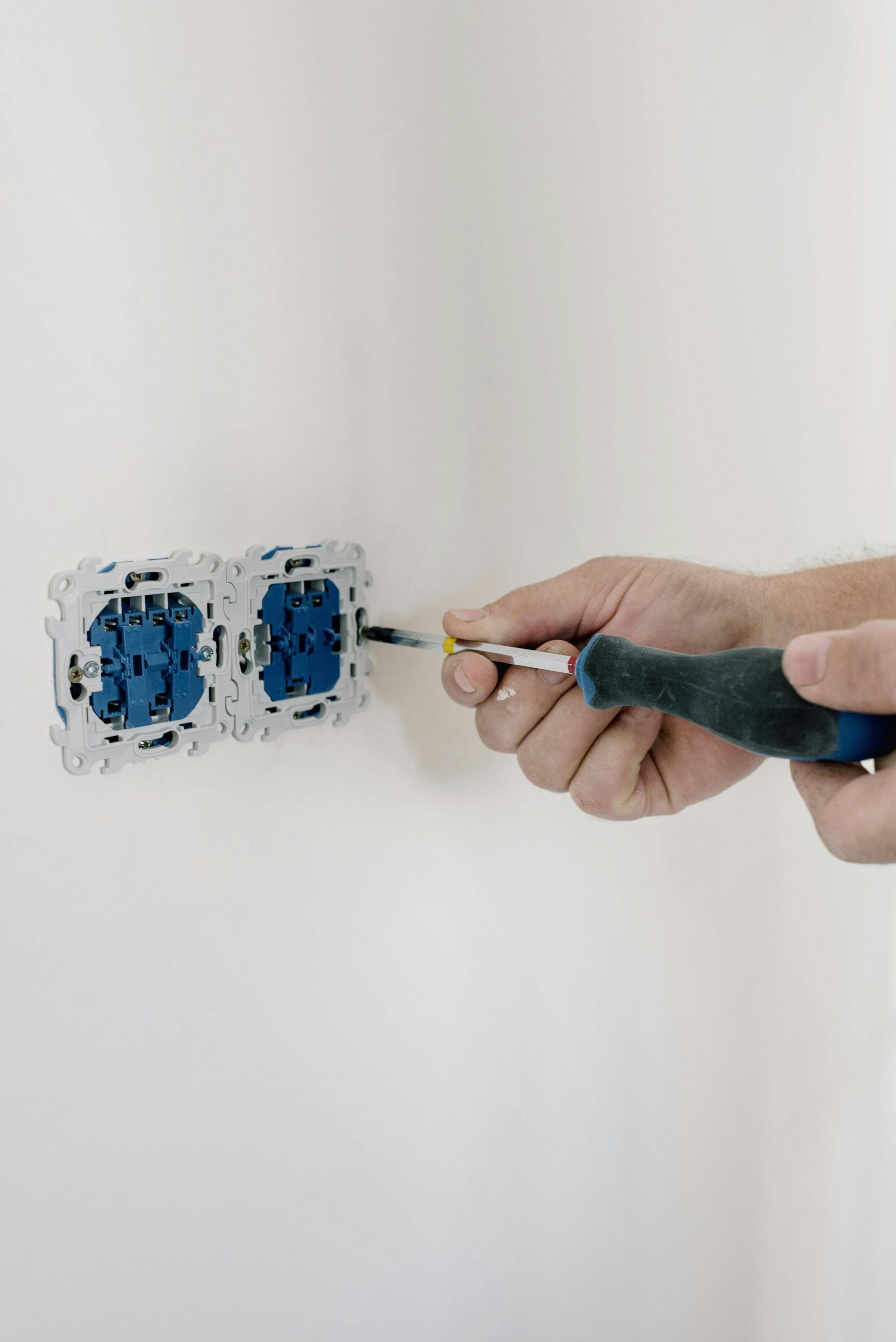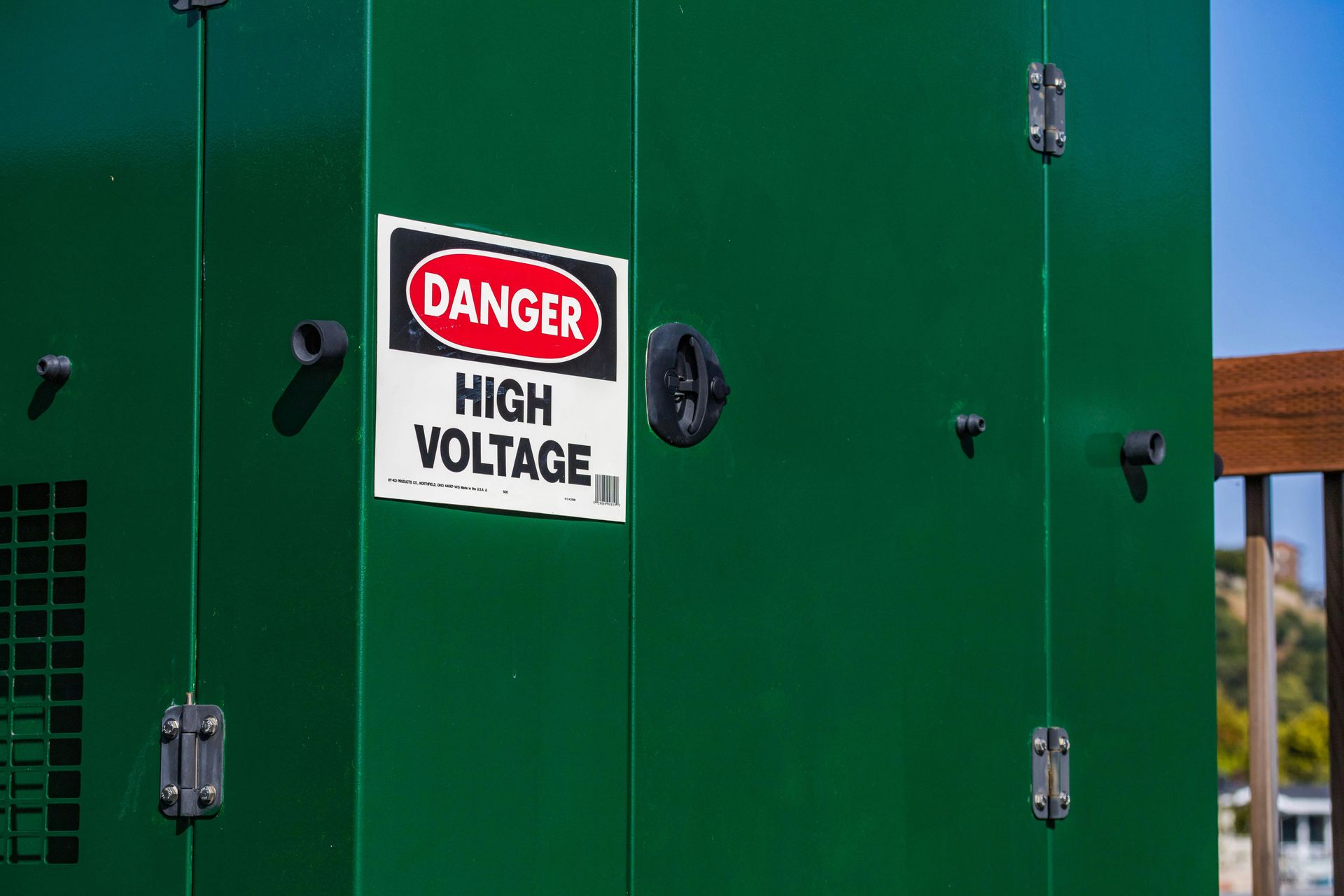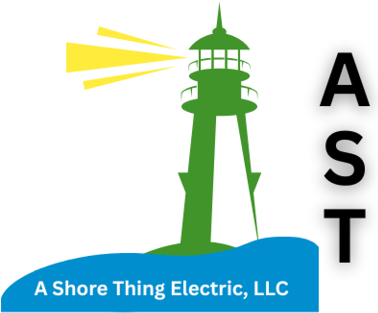Top 10 Electrical Safety Tips for Howell Homeowners This Year
Hey Howell homeowners, keep your electrical cords in tip-top shape by ditching frayed ones pronto, and don’t overload outlets—your power strip isn’t a supercharger!
Install GFCIs near water spots, keep gadgets dry, and get routine check-ups on your electrical system. Teach kids to respect electricity, keep panels clear, and call pros for upgrades or fixes—old wiring can be a fire waiting to happen. Stick around to find out how to keep your home shock-free and safe!
Key Takeaways
- Regularly inspect and promptly replace damaged electrical cords to prevent shocks and fire hazards.
- Avoid overloading outlets by distributing plugs and not daisy-chaining power strips.
- Install and test GFCIs monthly in kitchens, bathrooms, and other wet areas to prevent electrical shocks.
- Schedule electrical system inspections every 1-5 years based on your home's age for early issue detection.
- Hire licensed electricians for repairs, upgrades, and to ensure compliance with local safety codes.
Inspect and Replace Damaged Electrical Cords
Before you plug in that favorite lamp or your trusty old coffee maker, take a quick look at the cords — they might be hiding some trouble. You’d be surprised how often frayed or cracked cords sneak past us, quietly risking sparks or shocks.
Good cord maintenance isn’t just about safety; it’s about keeping your cozy space just right. When you spot wear or exposed wires, don’t shrug it off or tape it up as a “quick fix.” Replace those cords promptly to avoid bigger headaches.
If your home’s seen a few decades, it might be time to think about electrical upgrades, too. Newer cords and outlets not only look better but handle power more safely and efficiently.
You deserve a home that’s both comfy and secure, so take a few minutes to inspect those cords. It’s a small step that makes a big difference for you and everyone sharing your space.
Avoid Overloading Power Outlets
Keeping an eye on your cords is a smart move, but it’s just one piece of the puzzle. You’ve got to watch how many devices you plug into a single outlet, too. Every outlet has a limit—its outlet capacity—and when you push it past that, you risk overheating and even fires.
Think about the electrical demand of each gadget you’re using. A phone charger is small potatoes, but a space heater or microwave? Those suck up a lot more juice.
If you’re stacking power strips or using too many high-power devices in one spot, you’re flirting with trouble. Spread out your plugs around the room, and don’t daisy-chain power strips like they’re a necklace.
It’s all about balance—like a good group chat, everyone gets their turn without overwhelming the conversation. Keep your home safe by respecting your outlets’ limits, and you’ll avoid those sudden sparks nobody wants to see.
Install Ground Fault Circuit Interrupters (GFCIs)
You’ll want to install Ground Fault Circuit Interrupters, or GFCIs, to keep your home safer from electrical shocks.
They’re especially handy in spots where water and electricity mix, like bathrooms, kitchens, and outdoors.
Trust me, setting these up is a smart move that can really save you from a shocking surprise!
GFCI Benefits
Even if you’re not an electrician, installing Ground Fault Circuit Interrupters (GFCIs) is one of the smartest moves you can make to keep your home safe.
The GFCI advantages go beyond just preventing shocks—it actually senses tiny electrical leaks and cuts power fast. That quick response can stop accidents before they even start, which is pretty awesome.
When you consider GFCI installation, you’re investing in peace of mind for your family and guests. Plus, they’re not too tricky to add, especially when you call in a pro.
You’ll join countless homeowners who’ve boosted their home’s safety with this simple gadget. It’s like giving your house a tiny superhero that’s always on guard, ready to protect everyone inside. Who wouldn’t want that?
Installation Locations
Knowing where to install GFCIs can make all the difference in keeping your home safe from electrical hazards. You’ll want to focus on both indoor placements and outdoor installations.
Inside, kitchens, bathrooms, and laundry rooms are must-haves since water and electricity don’t mix well—kind of like oil and water, but with sparks.
Outdoors, think about areas like patios, garages, or anywhere you plug in tools or lights. These spots get wet or damp, so GFCIs act like your home’s electrical bodyguard, cutting power fast if something’s wrong.
Installing them in the right places isn’t just smart; it’s a way to protect everyone who lives in or visits your home. Trust me, your family and your wiring will thank you!
Keep Electrical Devices Away From Water
You wouldn’t want your phone or toaster taking a swim, right?
Keeping electrical devices away from water isn’t just common sense—it’s a lifesaver, literally, since water and electricity are a shocking combo.
Plus, using ground fault circuit interrupters (GFCIs) helps catch any sneaky leaks before they zap you, so it’s smart to have them around where water hangs out.
Prevent Electrical Shock
Since water and electricity are a dangerous mix, it’s smart to keep your gadgets far from sinks, bathtubs, and puddles. You don’t want a surprise zap ruining your day—or worse.
When you focus on electrical safety, you’re not just protecting yourself but everyone in your home. Shock prevention starts with simple habits, like never handling devices with wet hands and unplugging appliances before cleaning.
Think of it as a team effort—you, your family, and your home all working together to stay safe. And hey, avoiding water near outlets isn’t just smart; it’s a no-brainer.
Use Ground Fault Circuit
A good rule of thumb is to have Ground Fault Circuit Interrupters (GFCIs) installed wherever water and electricity might get too cozy—like kitchens, bathrooms, and laundry rooms.
These handy devices protect you by cutting off power the moment they detect a ground fault, which happens when electricity sneaks through water or your body.
For solid circuit safety, remember to:
- Install GFCIs near sinks, tubs, and outdoor outlets
- Test your GFCIs monthly to verify they work right
- Keep electrical devices away from wet hands and surfaces
- Avoid using extension cords in damp areas
- Replace old outlets with GFCI ones for extra protection
- Schedule Regular Electrical System Inspections
Getting your electrical system checked at least once every few years can save you a lot of headaches down the road. Regular electrical assessments help catch small problems before they turn into costly repairs or safety hazards.
You might wonder how often you should schedule these check-ups—inspection frequency often depends on your home’s age and electrical use. Staying on top of this keeps you and your family safe, and it’s a smart move for your peace of mind.
Here’s a quick look at recommended inspection frequency:
| Home Age | Inspection Frequency |
|---|---|
| Less than 10 years | Every 5 years |
| 10-30 years | Every 3 years |
| Over 30 years | Every 1-2 years |
Think of these inspections like your home's yearly physical. It’s about keeping things running smoothly so you can relax and enjoy your space without worry.
Use Surge Protectors for Sensitive Electronics
Keeping up with regular inspections is a smart move, but protecting your electronics from sudden power spikes is just as important.
Surge protection isn’t just a fancy term—it’s your best buddy when it comes to guarding your electronic devices against unexpected electrical jolts. These spikes can fry your gadgets in a blink, leaving you with costly repairs or replacements.
Here’s how you can keep your devices safe and sound:
- Use quality surge protectors, not just basic power strips.
- Plug sensitive devices like computers, TVs, and gaming consoles into surge protectors.
- Avoid daisy-chaining multiple surge protectors—it’s tempting but risky.
- Replace surge protectors every few years to guarantee they’re still effective.
- Unplug devices during storms if you can’t use surge protection.
Teach Children About Electrical Safety
Since kids are naturally curious, teaching them about electrical safety early on can save you a lot of headaches (and maybe a few trips to the emergency room).
You want your little ones to grow up knowing how to handle electricity safely, so start by explaining why plugs, outlets, and cords aren’t toys. Make it fun and simple—use stories or cartoons to show what happens if they’re careless.
Encourage safe habits like never sticking fingers or objects into outlets and always asking an adult before touching electrical devices.
You’re not just protecting your home; you’re helping your kids build lifelong respect for electrical safety. When they understand the risks and learn safe habits, they’ll feel more confident and responsible.
Plus, it brings peace of mind to you and everyone in your Howell neighborhood. So, take a few minutes to chat with your kids about electricity—it’s a small step that makes a big difference!
Maintain Clear Access to Electrical Panels
You’ll want to keep the area around your electrical panel clear, so nothing blocks your way when you need quick access.
It’s like leaving the front door open for emergencies—easy to get to means safer for everyone.
Plus, no one wants to play “move the boxes” in a rush, right?
Keep Panel Area Unobstructed
At least one clear path to your electrical panel is a must-have for any home. You want quick, easy access for panel maintenance and to spot any issues fast.
Plus, safety signage should always be visible to warn everyone around. Here’s how you can keep that area unobstructed:
- Don’t stack boxes or furniture nearby.
- Keep the floor around it clutter-free.
- Hang tools and gear somewhere else.
- Make sure pets can’t block the panel.
- Regularly check that safety signs aren’t covered.
Ensure Easy Emergency Access
Even if you’re not an electrician, you can see how important it's to get to your electrical panel quickly when things go sideways. That’s why you want to keep your access routes clear and easy to follow.
Imagine fumbling around in the dark during a power outage—emergency lighting near your panel can be a real lifesaver, helping you spot switches without turning your house into an obstacle course.
Make sure nothing—boxes, furniture, or even your dog’s favorite nap spot—blocks the way. It’s not just about convenience; it’s about safety for you and everyone in your home.
When you maintain clear access, you’re making sure everyone can pitch in if needed, and that’s what being part of a caring household is all about.
Hire Licensed Electricians for Repairs and Upgrades
Although tackling small fixes around the house can feel pretty rewarding, when it comes to electrical repairs and upgrades, it’s best to call in a licensed electrician.
Trust me, the licensed electrician benefits go beyond just getting the job done right—they assure your home stays safe and up to code.
Electrical repair importance can’t be overstated; a tiny mistake might lead to bigger hazards like fires or shocks.
Here’s why you should stick with pros:
- They've the right training and tools.
- They know local codes and safety standards.
- They can spot hidden issues you might miss.
- Their work is usually guaranteed.
- They help keep your insurance valid.
Upgrade Outdated Wiring and Fixtures
Since your home's wiring and fixtures take a lot of daily wear and tear, it’s smart to think about upgrading them if they’re outdated. Outdated wiring can be a hidden danger, increasing the risk of electrical fires or sudden outages that nobody wants.
Plus, old wiring mightn't handle all the gadgets you’ve got plugged in these days. Fixture upgrades aren’t just about looks either—they improve safety and energy efficiency. Swapping out old switches, outlets, or light fixtures can prevent shocks and keep your home running smoothly.
If you notice flickering lights or outlets that feel warm, it’s a clear sign your wiring or fixtures need attention. Remember, upgrading outdated wiring and doing fixture upgrades is an investment in your home’s safety and your peace of mind.
You’re not just keeping the lights on—you’re keeping everyone safe and cozy. And hey, who doesn’t want a home that’s both safe and stylish?
Frequently Asked Questions
How Often Should Smoke Detectors Be Tested in My Home?
You should test your smoke detectors monthly to guarantee they work properly. Using simple testing methods like pressing the test button keeps your home safe and shows you care about your loved ones’ well-being and belonging.
What Are the Signs of Electrical Shock Hazards?
You’ll spot electrical shock hazard signs like flickering lights, burning smells, or warm outlets. If you notice frayed wires or frequent breaker trips, trust your instincts—they’re warning you to act and keep your home safe.
Can Solar Panels Affect My Home's Electrical Safety?
Oh, solar panels never impact your home's electrical safety, right? Actually, your solar panel installation and regular electrical system maintenance play key roles in keeping everything safe. Join others who prioritize safety and stay secure together!
Are There Specific Safety Tips for Outdoor Electrical Equipment?
When using outdoor extension cords, you should always check for damage and keep connections dry. Regular electrical maintenance guarantees safety, and by doing this, you join others who care about protecting their homes and community.
How Do I Safely Reset a Tripped Circuit Breaker?
When your circuit breaker trips due to an electrical overload, turn off all devices first. Then, firmly switch the breaker to the OFF position before flipping it back ON. This keeps you and your home safe together.
Final Thoughts
Keeping your home’s electrical system safe doesn’t have to be a headache. By checking cords, avoiding overloaded outlets, and calling pros when needed, you’re already ahead of the game.
Remember, those little things like teaching kids or keeping water away can make a big difference. So, don’t wait for sparks to fly—stay proactive, stay safe, and enjoy peace of mind. After all, a safe home is a happy home, right?



